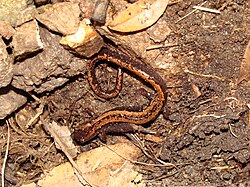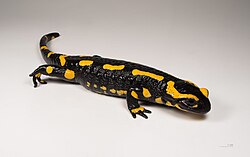| Species | Common name and vernacular name (VN) [Note 1] | Distribution | Description [Note 2] | Status [Note 3] | Imagen |
|---|
| Scincidae Gray, 1825 |
| Chalcides bedriagai [27] | Bedriaga's skink NV: (in Spanish) Eslabón, enano, nánago, enánago, inano, ánago, anagón. |  | Small sized lizard, with a small, triangular, broadened head and rounded snout. Short and thick body with rounded or quadrangular section, covered with smooth and shiny scales. Small limbs, tail of circular section of lesser length than the body. | |  |
| Chalcides striatus [28] | Western three-toed skink NV: (in Spanish) Eslabón, enano, nánago, enánago, inano, ánago, anagón. |  | Very similar to the Bedriaga's skink, whose main difference is that it has only three toes on each limb. | |  |
| Lacertidae Gray, 1825 |
| Iberolacerta monticola [29] | Iberian rock lizard |  | Medium-sized lizard, robust appearance and relatively flattened head. The back is brownish or bright green with black reticulation, the belly is whitish, bluish or greenish-yellow with black spots. Blue axial ocelli. | |  |
| Timon lepidus [30] | Ocellated lizard NV: (in Spanish, common to all lizards) Legarto/u, regartezón. |  | L: 22.5 cm. Lt: 75.5 cm; 59.4 cm (female). It is the largest Iberian lizard. Its layer is yellowish green in males and brownish in females, in both mottled in black. On the sides they have blue ocelli that may or may not be framed in black. Their underside is whitish. Juveniles are usually greenish with white ocelli on the back and sides. | | 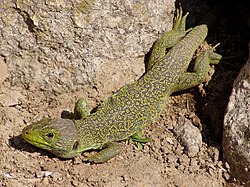 |
| Lacerta schreiberi [31] | Iberian emerald lizard |  | Lt: 40 cm Short and wide head, the tail is twice as long as the body and its belly is yellowish. Males are green vermiculated in black, with age the black decreases. During estrus, their head and throat turn blue. Females have a brownish or greenish coloration. | |  |
| Lacerta bilineata [32] | Western green lizard |  | L: 12 cm Coat yellowish green, bluish green or brownish green with black speckles. Males have a blue throat and females and juveniles have 2 dark longitudinal stripes. | |  |
| Zootoca vivipara [33] | Viviparous lizard NV: (in Spanish, common to all lizards) Lagartesa, ligartesa, lagarteza, ligaterna, legaterna, regarteza. |  | L: 6.5 cm; 7.5 cm (female) They have a long tail, between 1.1 and 2.5 times the length of the body. They are brownish or grayish in color with dark and light longitudinal stripes. Juveniles are usually completely blackish. | |  |
| Podarcis hispanicus [34] | Iberian wall lizard |  | L: 4.2-5.9 (6.5) cm; 4.1-5.7 cm (female). T: 10 cm Color greenish-brown very variable, with yellowish chest and occasionally reddish head and back. It has spots in males and lateral stripes in females, among which stand out two thick and dark ones that may be outlined by other thinner yellowish ones. | |  |
| Podarcis muralis [35] | Common wall lizard |  | L: 7.7 cm; 7 cm (female) A slender lizard with a brownish or grayish back and whitish belly. It has a line of dots in the center of the back and a wide, dark longitudinal stripe on the sides, flanked by two light stripes that pass above and below the eyes. Its pupils are reddish. | | 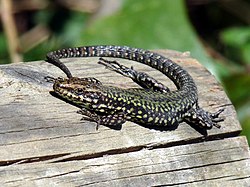 |
| Podarcis sicula * [36] | Italian wall lizard |  | L: (9 cm). Males have a longer tail. Green lizard with three dark longitudinal stripes, one in the center of the back and two on the sides, dotted with light ocelli. | * In Cantabria |  |
| Psammodromus manuelae [4] [37] | (In Spanish ) Lagartija colilarga occidental |  | L: 7-7.5 cm Coloration of the back is light brown, coppery brown or olive, with two whitish or yellowish lines. Eyelids bluish on each side of the body, decreasing in size towards the back. In spring, adult males have orange and yellow sides of the head and throat, and the sides with abundant black coloration forming parallel vertical series alternating with yellow coloration. | |  |
| Gekkonidae Oppel, 1811 |
| Tarentola mauritanica * [38] | Common wall gecko | | L: 5-7 cm. T: 5-8 cm The back, legs and tail have prominent conical bumps. The head is large and broad, triangular and has large eyes with vertical pupil without eyelids. Its coloration can vary from brown to dark gray, with spots; the belly is whitish. It has five toes on each leg, with lateral and lower lamellar protuberances that provide some grip for climbing and moving along vertical surfaces. | | 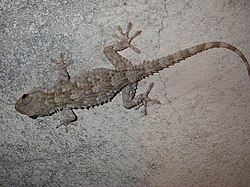 |
| Tarentola delalandii * [39] | Tenerife gecko | | Lt: 73 cm; 63 cm (female) A large, robust gecko with a gray dorsum with dark, inconspicuous transverse stripes followed by light spots and a whitish or yellowish underside. Its iris is yellowish or golden brown. | |  |
| Anguidae Gray, 1825 |
| Anguis fragilis [40] | Slow worm NV: (in Spanish) Enánago, nánago/u, [41] enanu, inanu, ánago, anagón, alamón, eslabón, cedajón, salayón, babón, gamón. |  | Lt: 30-40 cm; 50 cm (female) Legless lizard. Body with hard brownish scales. Movable eyelids. | |  |
| Colubridae Oppel, 1811 |
| Coronella austriaca [42] | Smooth snake NV: (In Spanish, common to all the family) Culiebra, culiebru. |  | Lt: 50-60 (75) cm The color of the back varies from reddish-brown to gray, with irregular dark spots. The belly is blackish, grayish or reddish-brown in a more or less uniform pattern. A dark mask runs from the nostrils and lower edge of the eye to the neck. | | 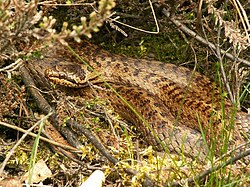 |
| Coronella girondica [43] | Southern smooth snake |  | Lt: 67.7 cm; 80 cm (females) It has a small and sunken head and a relatively short tail. Its coloration varies between brown, ocher, gray, pink and reddish tones. It has two dark spots on the parietals extending backwards, its back is covered with dark transverse spots, sometimes with reddish spots on the sides. | |  |
| Natrix maura | Viperine water snake | 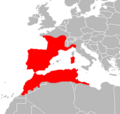 | Lt: 50-70 (80) cm Coloration very varied, generally olive or yellowish brown, although it can also be reddish. It has along the mid-dorsal line a row of spots that in some specimens may come together to form a zigzag line. It is characterized by showing very carinate scales on the back. | |  |
| Natrix natrix [4] | Grass snake NV: (in Spanish) Culebra collarina, serpiente de los prados. [41] |  | Lt: 120 (200) cm It has a thick body, rounded head and eyes with round pupils. The color is very variable, most commonly brown or dark green. | | 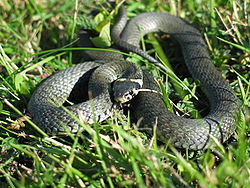 |
| Zamenis longissimus [4] | Aesculapian snake |  | Lt: (225) cm. Head is elongated and narrow. Brownish, greenish or grayish coloration on the back, with whitish specks on the sides. Yellow underside as well as the sides of the neck. | |  |
| Viperidae Oppel, 1811 |
| Vipera aspis [4] | European asp viper | 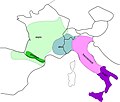 | L: 60 (85) cm; (75) cm (female). Relatively short tail. Head broad, triangular and distinct from the neck. Body scales grayish or yellowish, golden or coppery, with black or greenish spots with black border, in apparent zigzag on the back. | |  |
| Vipera latastei [4] | Lataste's viper |  | Lt: 50 (70) cm. Broad back of the head and triangular muzzle ending in an upward prominence. Short tail. Its color varies from gray to brown and has a zigzag band running down the back. | |  |
| Vipera seoanei [4] | Baskian viper or Seoane's viper |  | L: 45-48 (75) cm Large head and flattened or slightly raised muzzle. Small tail (10-15% of the total). Notable individual and geographic variation in color pattern; the background is usually light brown but its pattern may be in a rosary pattern, zig-zag, discontinuous spots or even bilinear. | | 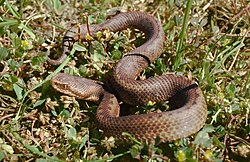 |
|


























